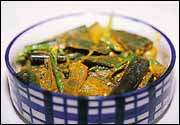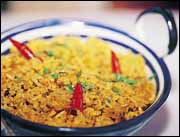|
MOST gourmets find it hard to believe that there is no culture of non-vegetarian food in Banaras. Forget meat, there is not even chicken in the Banarasi's diet, nor fish. They assume that just because India's greatest river flows through the city, there should also be some form of sweet-water, river fish in the Banarasi's menu. Like there is in Calcutta because of the Hooghly. Astonished first-time visitors to the Holy City say, "But how can that be, how can there be no non-vegetarian food in Banaras!" I think they connect Banaras' proximity to Lucknow with the rich, non-vegetarian Mughlai food of that city. But Lucknow is the City of Nawabs, and Banaras... the City of Gods! And if the Gods must be appeased, then you must do so by going on a strict Satvik diet.
In Banaras, despite the great cuisine that a Satvik lifestyle throws up, food is merely a medium of survival. Food is life, say the Upanishads, the Hindu scriptures, and it is food that enables a man to make use of all his faculties. If you are pursuing spiritual advancement, then you must have purity of thought. And because purity of thought is said to depend entirely on purity of food, Satvik Khana is big business in Banaras.
 Very simply, Satvik Khana is pure and fresh vegetarian food that is prepared without the influence of onion and garlic, and with very little spices. It is not true that you cannot have an Indian meal without spices. Spices have an affect on the body and mind. And if you want to keep your senses under control so that you might attain spiritual enlightenment, then you have to rule out foods that do not bring about a harmonious balance between the various aspects of your existence. Onion and garlic are two of them!
Very simply, Satvik Khana is pure and fresh vegetarian food that is prepared without the influence of onion and garlic, and with very little spices. It is not true that you cannot have an Indian meal without spices. Spices have an affect on the body and mind. And if you want to keep your senses under control so that you might attain spiritual enlightenment, then you have to rule out foods that do not bring about a harmonious balance between the various aspects of your existence. Onion and garlic are two of them!
Why is there no onion and garlic in Satvik food? They generate heat. And they act as aphrodisacs too! The sages believe that if you cannot keep sexual desires under control, and the mind too, then you will not be able to maintain a balance in your body. You will not be dedicated and focussed in your goal of attaining spirituality. Besides, the very essence of Satvik Khana, which is purely vegetarian food cooked lightly and with little oil and spices, brings out the flavours of the vegetables to optimum. You do not need onion and garlic in this cuisine. The pilgrim to Banaras should base his culinary needs on those of Lord Shiva's, the ruling deity of the Holy City. Shiva's demands are limited because he is an ascetic. Food for this Lord consistes of sugar, rice, ghee, grain and the bel fruit (woodapple) and its leaves. Shiva also likes to be bathed in milk, and milk finds its place in Satvik Khana too.
 Who eats Satvik Khana? The Gods and Saints eat Satvik Khana! But in Banaras, it is the cuisine of all Hindus, especially Jains, Brahmins, Pandits, and even the Thakurs, who are non-vegetarian eaters. There are basic masalas that go into Satvik Khana like salt, haldi, red chilli is sparingly used, the powder, not the full chilli, and there is extensive use of hing, or asafoetida. That is because the cuisine needs some sort of flavouring. Garlic enhances flavour, but garlic is no-no in Satvik Khana, therefore, there is reliance on hing. Hing has other properties besides being an added-value to food. It also acts as an antiseptic agent and a digestive. And there are a variety of vegetables used in the cuisine, these are cooked in a simpe chaunk, or a tadka of hing, cumin seeds and mustard seeds. Vegetables like potato, green peas, aubergines, lady's fingers, cabbage, raw plantain, black carrot, all kinds of lentils. Saatvik Khana is
very easy to prepare. The basic rule is that the fresher the food is served, the
better it is.
Who eats Satvik Khana? The Gods and Saints eat Satvik Khana! But in Banaras, it is the cuisine of all Hindus, especially Jains, Brahmins, Pandits, and even the Thakurs, who are non-vegetarian eaters. There are basic masalas that go into Satvik Khana like salt, haldi, red chilli is sparingly used, the powder, not the full chilli, and there is extensive use of hing, or asafoetida. That is because the cuisine needs some sort of flavouring. Garlic enhances flavour, but garlic is no-no in Satvik Khana, therefore, there is reliance on hing. Hing has other properties besides being an added-value to food. It also acts as an antiseptic agent and a digestive. And there are a variety of vegetables used in the cuisine, these are cooked in a simpe chaunk, or a tadka of hing, cumin seeds and mustard seeds. Vegetables like potato, green peas, aubergines, lady's fingers, cabbage, raw plantain, black carrot, all kinds of lentils. Saatvik Khana is
very easy to prepare. The basic rule is that the fresher the food is served, the
better it is.
|



 Banarasi Satvik Khana, Food Fit For The Gods!
Banarasi Satvik Khana, Food Fit For The Gods!

 Very simply, Satvik Khana is pure and fresh vegetarian food that is prepared without the influence of onion and garlic, and with very little spices. It is not true that you cannot have an Indian meal without spices. Spices have an affect on the body and mind. And if you want to keep your senses under control so that you might attain spiritual enlightenment, then you have to rule out foods that do not bring about a harmonious balance between the various aspects of your existence. Onion and garlic are two of them!
Very simply, Satvik Khana is pure and fresh vegetarian food that is prepared without the influence of onion and garlic, and with very little spices. It is not true that you cannot have an Indian meal without spices. Spices have an affect on the body and mind. And if you want to keep your senses under control so that you might attain spiritual enlightenment, then you have to rule out foods that do not bring about a harmonious balance between the various aspects of your existence. Onion and garlic are two of them!
 Who eats Satvik Khana? The Gods and Saints eat Satvik Khana! But in Banaras, it is the cuisine of all Hindus, especially Jains, Brahmins, Pandits, and even the Thakurs, who are non-vegetarian eaters. There are basic masalas that go into Satvik Khana like salt, haldi, red chilli is sparingly used, the powder, not the full chilli, and there is extensive use of hing, or asafoetida. That is because the cuisine needs some sort of flavouring. Garlic enhances flavour, but garlic is no-no in Satvik Khana, therefore, there is reliance on hing. Hing has other properties besides being an added-value to food. It also acts as an antiseptic agent and a digestive. And there are a variety of vegetables used in the cuisine, these are cooked in a simpe chaunk, or a tadka of hing, cumin seeds and mustard seeds. Vegetables like potato, green peas, aubergines, lady's fingers, cabbage, raw plantain, black carrot, all kinds of lentils. Saatvik Khana is
very easy to prepare. The basic rule is that the fresher the food is served, the
better it is.
Who eats Satvik Khana? The Gods and Saints eat Satvik Khana! But in Banaras, it is the cuisine of all Hindus, especially Jains, Brahmins, Pandits, and even the Thakurs, who are non-vegetarian eaters. There are basic masalas that go into Satvik Khana like salt, haldi, red chilli is sparingly used, the powder, not the full chilli, and there is extensive use of hing, or asafoetida. That is because the cuisine needs some sort of flavouring. Garlic enhances flavour, but garlic is no-no in Satvik Khana, therefore, there is reliance on hing. Hing has other properties besides being an added-value to food. It also acts as an antiseptic agent and a digestive. And there are a variety of vegetables used in the cuisine, these are cooked in a simpe chaunk, or a tadka of hing, cumin seeds and mustard seeds. Vegetables like potato, green peas, aubergines, lady's fingers, cabbage, raw plantain, black carrot, all kinds of lentils. Saatvik Khana is
very easy to prepare. The basic rule is that the fresher the food is served, the
better it is.